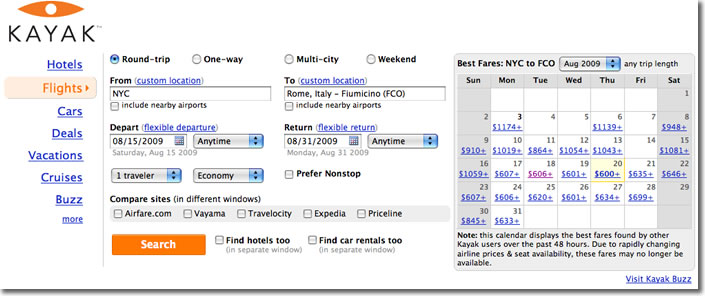Cheap Airfare Step 1: Time buying your plane tickets just right
Timing is the key to saving a bundle on airfare
In travel planning, as in life, timing is everything. To maximize your vacation dollars, you want to travel at the right time, buy your plane ticket at the moment when prices are at their lowest (and on the cheapest days of the week to buy), know what days are cheapest to travel, and learn how to be flexible enough to take advantage of the best deals.
Travel seasons: High, low, and shoulder
Track fares and research when to buy with Bing.com, FareReport.com, Yapta.com.Europe and pther temperate zones enjoy roughly the same seasonal calendar as North America.
(We'll talk Europe and North America here, since they have the highest seasonal variation in airfares; for seaosnal details on other destinations, see the "Travel Seasons" page)
In Europe, Summer is high season (nicest—or at least most consistently hot—weather, and, since school is out, families can take vacation).
Winter is low season (with the exception of the popular Christmas break creating a high season bubble from mid-December through early January).
Fall and spring are the shoulder seasons—temperate, though moody, weather and moderate crowds.
There are exceptions: Obvious seasonal destinations as beaches (crazy crowded in summer; dead in winter) and ski resorts (booming in winter, shut down tight in June—though the rest of summer sees a moderate flow of tourists there to drive scenic roads or hike mountain trails).
| Know thy travel seasons in Europe | |
Jan 7–Mar 31 |
Low |
Apr 1–Jun 14 |
Shoulder |
June 15–Aug 31 |
High |
Sep 1–Oct 31 |
Shoulder |
Nov 1-Dec 14 |
Low |
Dec 15–Jan 6 |
High |
For the purposes of pricing airline tickets (and, especially in beach or resort destinations, hotel rooms), the travel industry basically recognizes three travel seasons: high season (for Italy: June 15–Aug 31 and Dec 15–Jan 6), low season (Nov-Mar, excluding Christmas), and shoulder season (fall and spring).
Not to belabor the obvious, but high season brings the highest prices, largest crowds, least room to bargain (and hottest temperatures; Italy and Greece in August can be brutal).
On the plus side, high season is also often when you'll find the most festivals—plus, all the sights, restaurants, hotels, and other businesses of interest to tourists will be open and generally keeping their longest hours.
Low season has the lowest prices, smallest crowds, and most room to bargain. The downsides to low season are a chance for crummy weather—often wet in spring and fall and cold in winter, but not too bad—and, especially in smaller towns and resort areas, the likelihood that many tourist sights and services will be shut down.
Shoulder season, as you might imagine, falls somewhere in between—not too crowded or too empty, generally pleasant weather, most things open—making it insanely popular among savvy travelers who are able to arrange their calendars to take advantage of it.
» More on when to travel ![]()
Buy at the right time - The sweet spot is 6–12 weeks out
Never buy your plane tickets more than about four months before your departure date. Why? Because no one is discounting those seats yet, so you'll pay top dollar—which is misleadingly called the "lowest published fare."
But don't wait too long to buy, either.
A few years ago, the troubled airlines were throwing near-daily last-minute fire sales of unsold seats in a desperate attempt to avoid flying half-empty planes.
These days, the airlines have gotten much better at flying only as many planes as they can fill—which means last minute deals are far less common than flights that sell out.
What's the sweet spot, then? I’d say (a) check out the undiscounted rack rate for your intended flight about four months out, (b) then idly keep track of the fares and keep an eye out for sudden sales, and (c) if no sale comes along by about ten to eight to twelve weeks out from your travel date, then you go ahead and buy.
At eight weeks is when airfare consolidators lock in their fares, and most airlines will already be running sales by then if they plan to.
Keep in mind that, as a general rule, the cheapest tickets will sell out more quickly during peak travel season. Last-minute sales will pop up closer to travel dates in low season.
In other words, wait a bit longer to buy in winter than you would in summer.
(Of course, if you plan to fly a highly specialized route with few departures—like my 19-seater flight from Denver to Moab this past summer—these rules do not apply. On these routes, the fares stay pretty steady until the plane fills up, at which point you're out of luck, so book those as soon as your travel dates are set.)
What day is the best to look for low fares?
Generally speaking, you'll find the lowest airfares on Tuesday starting around mid-afternoon through Wednesday—especially for travel in the upcoming week or month.
There is a complicated alchemical reason for this, but all you really need to remember is to check over the weekend or on Monday to get a baseline for a standard fare, then check back starting around 3pm on Tuesday to see if it has suddenly dropped.
If the price hasn't changed much by Wednesday morning, go ahead and book.
Why is this so? In brief: One of the big "legacy airlines" (American, United, Delta, US Airways) will quietly jack up their fares on Fridays to see if the others will follow suit. By Monday, if no competitors matched the price bump, they will start easing fares back down. Then, on Tuesday morning, the low-cost carriers (Southwest, jetBlue, etc.) release their sale fares, and by mid-afternoon the legacy guys will be scrambling to cut their inflated fares to match.
That's when you have to strike.
By Thursday, the cheapest seats are sold out and you will see the remaining, higher fares for the remaining seats—in good old supply-and-demand fashion— start to creep up.
By Friday, the big airlines—proving corporations utterly lack any short term memory—start figuring they should jack up the price above last week's ceiling again, and the silly cycle repeats itself.
What days are the cheapest to travel?
As for what days are cheapest to travel, that varies widely.
Mid-week departures are general cheaper than weekend.
Stay over at least one Saturday night and fares will also drop.
(Another way to look at these two truisms: Leisure travelers who take off on Friday or Saturday for their vacations—or business travelers who make quick trips during the week—will both pay top dollar.)
Be flexible
Look into flights leaving or returning a day or two earlier or later for potentially huge savings.
Rather than bore you with details, just check out the image below.
This is a screen grab from a sample search I did using the aggregator Kayak.com. I started checking into fares from New York to Rome on August 15, and it instantly popped up a calendar to the right displaying the fares other users had found in the past 24 hours for travel on every day in August.
A quick glance shows me that, to fly on my intended date of Aug. 15 would cost a whopping $1,081. However, if I shift my trip plans and put off my departure by just two days, to Aug. 17, the price plummets to $607—a savings of $474.
Wow.
Now that's a savings—and an important tool in the savvy traveler's arsenal.
Even if you don't use sites that provide this intel automatically—even if you don't book online at all—always look into alternative travel dates. On other web sites, just test-drive sample dates through the booking engine—it won't take but 10 minutes or so.
If you prefer to book the old fashioned way—in person—tell the travel agent or airline booking agent on the phone that you are flexible with your departure and return dates. If they don't automatically provide the information on alternate dates, just persist politely and ask, "How much would it cost if I left a day or two earlier or later?"
It might take them a few minutes of tippy-tapping their keyboards while you wait, but as you can see, the wait can be more than worth it.
Related Articles
|
|
This article was by Reid Bramblett and last updated in June 2012.
All information was accurate at the time.
Copyright © 1998–2013 by Reid Bramblett. Author: Reid Bramblett.


